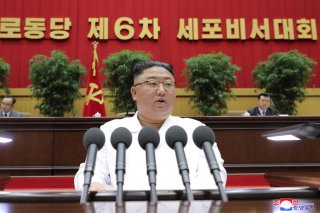Can Kim Jong Un Survive North Korea's Next 'Arduous March?'
Economically, it is clear that the Democratic People's Republic of Korea (DPRK) is in the midst of a grim period. Politically, however, North Korea is as constant as the North Star.
Stability isn’t the same as pregnancy; it isn’t a simple “yes” or “no” condition that is easily defined and (usually) recognizable. Instead, the spectrum ranges from the tremendously stable (iron-56 or the Burj Khalifa) to the incredibly unstable (New York Jets fans). And North Korea can fall on different places within that spectrum depending on what aspects of life are under consideration.
Economically, it is clear that the Democratic People's Republic of Korea (DPRK) is in the midst of a grim period. Evidence of the severity of the situation is everywhere, from Kim’s own statements to stories about food shortages and exorbitant prices to the drastic reduction in imports due to COVID. The stores and warehouses that line the streets near the Sino-Korean Friendship Bridge are closed or empty. The UN World Food Program warns that forty percent of the population is malnourished, while the North’s leadership advises its people to prepare for another “arduous march.” And, sadly, the worst is likely still to come.
Politically, however, North Korea is as constant as the North Star. In most countries, economic turmoil often breeds political instability. In the North, it usually does the opposite. The Kim family has typically used such internal challenges as a means to reinforce its domestic control. Sometimes the regime uses the turmoil as an excuse to increase its overt repression. Just as common, though, is their tendency to choose such moments to launch waves of external belligerency, in the likely hopes of sparking an international crisis that can rally the people behind them while also providing an enemy to scapegoat for their own leadership failures. As the economy crumbled in the late 1960s and Kim Il Sung faced his first mild stirrings of political opposition since 1956, he ignored the domestic suffering and instead launched a wave of military provocations that some have called “the Second Korean War.” The North repeated the pattern during the starvation years of the 1990s, begging for food aid from international sources while at the same time aggressively testing weapons, running covert operations against the South, and denouncing the same nations that were providing assistance. In both time periods, voices proclaimed that the economic instability might lead to the end of the despotic regime; one 1994 article in Contemporary Southeast Asia not only predicted an economic and political collapse but laid out a series of reforms to ease their forthcoming transition to a free-market economy, and advised that the North and South begin planning for reunification (including a warning that the South shouldn’t try to push democracy on the North too early in the process). Instead, to paraphrase Mark Twain, reports of the regime’s impending demise proved to be greatly exaggerated.
These lessons from the past carry a warning for those who see opportunity in the current situation. As it has in the past, the Kim family will likely emerge from this crisis just as firmly in control as it has been for decades. Signs are already suggesting a similar playbook is being engaged. As conditions worsen, a domestic crackdown is underway, as is a campaign to lobby verbal assaults against its traditional enemy across the Pacific. More provocative steps can be expected to follow, designed largely for domestic consumption as a means of rallying the people behind their leaders and re-directing their sense of grievance away from the Korean shores.
In the end, then, the North’s future seems to promise a selfish and perfidious stability at the top and a painful instability for everyone else. The more things change, the more they stay the same.
Mitchell Lerner is Professor of History and Director of the East Asian Studies Center at the Ohio State University, and associate editor of the Journal of American-East Asian Relations.
Image: Reuters

